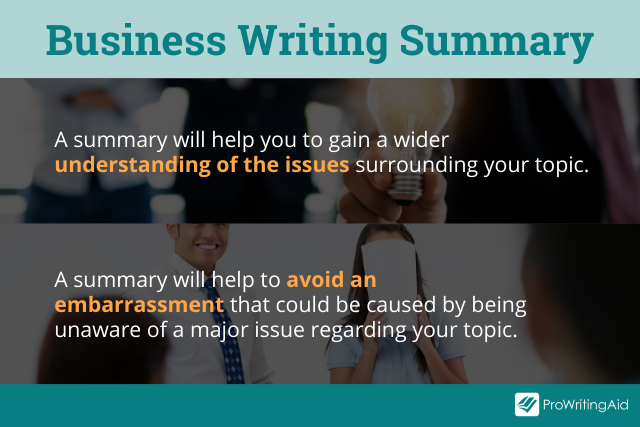
Business writing is any written communication used in a professional context.
There are many types of business writing, including emails and letters, marketing and sales materials, and administrative information, to name a few.
The primary goal of writing for business is to convey key information. In order to do this, the core message should be concise, clear, and direct without any unnecessary words or jargon.
The Importance of Business Writing Skills
All writing done for business has an objective, such as selling products or services, improving reputations, or building relationships.
All of these objectives help to improve the business and eventually increase revenue.
Clunky language and poor grammar can get in the way of these objectives and therefore hinder a business from growing and developing.
The following ten tips will help you achieve your business writing objectives and give you the best chance of success.
10 Tips to Improve Your Business Writing Skills
Although there are many intricacies when it comes to writing specific business materials, there are some core principles that you should follow.
1. Research Your Topic
Before you put pen to paper, it is important to do your research and understand what other people are saying about your topic.
There are two main reasons for doing this:
- It will help you to gain a wider understanding of the issues surrounding your topic.
- It will help to avoid any embarrassment that could be caused by being unaware of a major issue regarding your topic.
In business writing, what you don’t include is as important as what you do include.
2. Summarize Your Idea Before You Write
Instead of writing a detailed plan, try summarizing your purpose for writing into two sentences or fewer.
If you cannot do this then your idea is probably too complicated and you may want to return to the research stage to clarify your thoughts.
This technique will highlight if you have multiple topics that may best be split into multiple communications. Doing this should avoid any important information being skimmed over and missed.

Examples of business writing summaries:
- I am communicating this month’s sales statistics with the purpose of persuading the executive that our new marketing tactics are working and that the budget should be increased by 20 percent to encourage growth.
- This piece of training material intends to streamline the restock process by ensuring that each member of the team understands how to deal with damaged stock. This will reduce the involvement from the management team and therefore give them more time to complete administrative duties.
3. Avoid Unnecessary Jargon
Jargon is commonly used to impress rather than inform an audience. Impress your reader with your thoughts and ideas rather than the words you use to communicate them.
Some jargon is unavoidable but most can be reworded while still conveying the same message.
Instead of saying: “this is a resource-intensive project” you could say “we need a lot of people and money to complete this project.”
Instead of saying “this is a value-add proposition” you could say “this is a great idea.”
Both rewrites mean the same thing but are much more easily understood by a wider audience.
4. Be Impartial
In business writing you should aim to be impartial. This does not mean that you cannot include your own thoughts but that those thoughts should not be led by emotion.
Opinions led by reason are far more reliable and easier to justify than opinions led by emotion and therefore should be favored.
If you are particularly passionate about a subject, try to explain why, rather than just stating it. This is because emotional expressions, such as “we’re passionate about” or “I strongly feel/believe,” mean a different thing to each person. Facts and figures, however, are regulated, meaning that everyone understands them in the same way.
As a result, avoiding emotion words can help to control the way in which your business writing is interpreted.
Of course, if you are writing for a charity you are welcome to ignore this tip, but in 99 percent of cases it is best to keep emotional writing to a minimum.
5. Use the Active Voice
The active voice is stronger and easier to understand than the passive voice. It places the subject, rather than the action, at the center of attention.
It is stronger because it allows a person to directly take credit for an action. It is easier to understand because it is more logical and provides all the information, whereas the passive voice normally misses details.
For example, saying “the stock will be delivered on January 15” leaves the reader asking “by whom?” This is the passive voice.
The active version answers this question. “We will deliver the stock on January 15.”
The only caveat to this rule is if you are writing about a mistake and do not want to be held accountable for it.
For example, saying “mistakes were made” diverts attention from the people who made the mistake, therefore making them appear less culpable.

6. Edit for Clarity and Brevity
After writing your first draft, you will want to edit for clarity and brevity.
You should first edit for clarity by reading the piece as though you had not seen it before. Does it make sense? Does it convey the correct message? Does it only include essential information? If you can answer yes to these three questions, you are ready to edit for brevity.
When it comes to writing for business, less is more, and this is where the second edit comes in.
Editing for brevity can be hard because this stage requires you to delete any unnecessary words. Keep in mind that these edits are improving your work and deleted work is not a waste of time.
Try not to keep sentences because they sound nice or took a long time to write. Only keep them if they genuinely contribute to the meaning of the piece.
7. Cross-Check Your Facts and Figures
After the first two edits, it is important to cross-check all facts and figures. Incorrect facts and figures will drastically reduce the impact of any argument you are trying to make, so they should be avoided.
You can easily lose hard-earned trust by mistakenly relying on incorrect data and it can be difficult to earn that trust back.
To avoid this you should double-check your own facts and then ask someone else to check them for you. It is all too easy to overlook mistakes when you know what they are meant to say.
8. Correct All Grammar and Spelling Mistakes
The fourth (and final) edit is to proofread for grammar and spelling. You may want to use a grammar checker at this stage to speed up the process.
With ProWritingAid’s Realtime Report, you can quickly get an overall perspective on your document in relation to industry-standard business writing. Choose from 9 business document types to match exactly the piece you are writing.

Try the Realtime report with a free accout.
The importance of good grammar cannot be overstated.
- It ensures that the meaning is clear.
- It makes writing easier and quicker to read.
- It creates confidence by establishing you as someone who is both educated and precise.
9. Make Use of Headings and Subheadings
Large blocks of text can be difficult to read and can lead to important information being missed by the reader.
Headings are beneficial for the reader because they allow for easier skim reading and provide small chunks of information, which are easier to digest.
Headings are also beneficial for the writer because they can help you to compartmentalize and clarify your thoughts.
It is far easier to identify superfluous information when you can clearly see the purpose of each section.
10. Always Include a Call to Action
All business writing has a purpose and that purpose is to incite action.
Make it clear what you want your reader to do in light of the information you have just provided them.
You can do this with a “call to action,” more commonly known as a CTA. It prompts an action from the reader that is beneficial to the person or company who created it.

If it is a sales piece, your call to action will ask readers to try or buy your product.
If it is an email, your call to action will probably ask the recipient to reply to you.
If it is a presentation, your call to action will likely be more subtle, asking readers to agree or consider your opinion.
Conclusion
There is no one-size-fits-all solution to business writing but there are best practices that will help you find the perfect solution for your business.
Before you put your pen down, ask yourself one question: Does this piece of writing fulfill the task it is designed for?
If you can nail the core content, everything else should come easily.
Do you have any indispensable business writing tips? Let us know in the comments.


